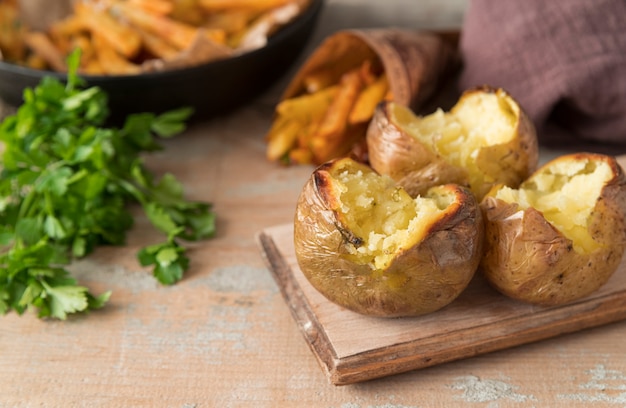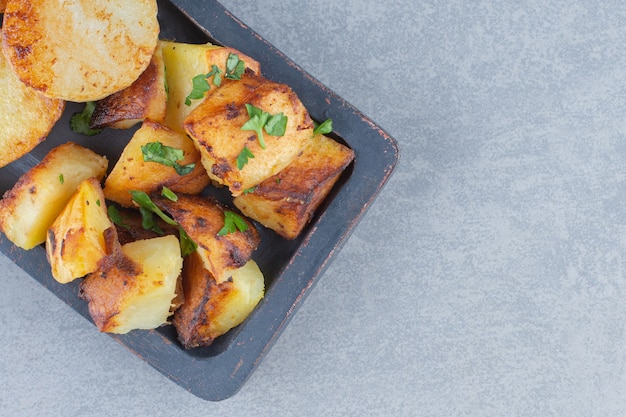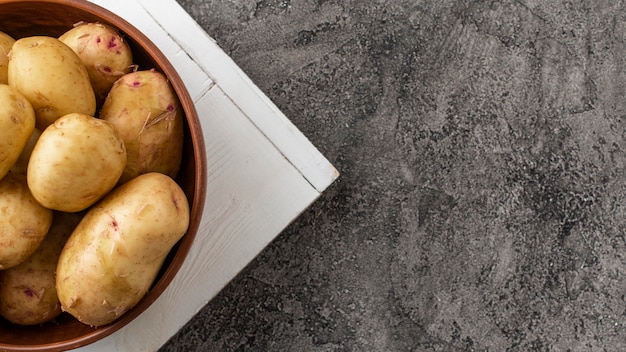The humble baked potato. A simple spud, yet capable of transforming into a culinary masterpiece. It's a blank canvas, ready to be adorned with a symphony of flavors, but before you even think about those toppings, there’s one crucial step: achieving that perfect bake. Imagine fluffy, pillowy insides, a crispy golden skin – a true potato nirvana!
My personal quest for the perfect baked potato spans decades, from childhood dinners to university nights in, to countless experiments in my own kitchen. I've tried it all, from different potato varieties to various ovens and cooking techniques. Along the way, I've learned a thing or two, and I'm sharing it all with you. This article is your guide to achieving that fluffy perfection, and hopefully, you'll find it just as helpful as I have.
Part 1: The Potato Powerhouse

Choosing the Right Spud
First things first, let's choose the right potato – the foundation of our culinary masterpiece. Not all potatoes are created equal, and for baking, we want a starchy variety. This ensures a potato that holds its shape, resisting crumbling during the bake and yielding those delightfully fluffy insides. The undisputed king of baking potatoes, in my book, is the maris piper. Its lovely floury texture transforms beautifully in the oven, creating a fluffy delight. But if you can't find a Maris Piper, don't despair! king edward and Desiree are also excellent contenders.
When selecting your potatoes, look for ones that are firm to the touch, free of blemishes, and about the size of a small grapefruit. Avoid potatoes that are green or have sprouts, as these indicate they’re starting to go bad.
Preparing Your Spud
Once you've chosen your perfect potato, it’s time to give it a good scrub. No need for soap or fancy cleaning products, just a good wash under running water. After scrubbing, give your potato a good poke with a fork or sharp knife. This is crucial for allowing steam to escape during the baking process, preventing those dreaded potato explosions (trust me, it’s happened to the best of us!).
Part 2: The Great Bake Off

Now we're ready for the main event, the actual baking process. This is where the humble potato transforms into a culinary delight. But before popping it in the oven, there are a few things to keep in mind.
Preheating Your Oven
The key to a perfectly baked potato? A hot oven. Preheating your oven to 200°C (400°F) ensures that crispy skin and fluffy interior we all crave. Remember, oven temperatures can vary, so keep a close eye on your potato and adjust the cooking time as needed.
The Art of Baking
Ready for the grand finale? Pop your prepared potato directly onto the middle rack of your preheated oven. You can choose to bake it directly on the rack for maximum crispiness or place it on a baking sheet for easier clean-up. Personally, I prefer the rack method for that extra crunch.
Part 3: The Time Factor

The big question: how long to cook your potato? Here’s where things get a bit tricky, as cooking time depends on the size of your potato and the temperature of your oven.
As a general rule, a medium-sized potato will take about 1 hour to bake. Smaller potatoes might only need 45 minutes, while larger potatoes could take up to 1 hour and 15 minutes. The best way to check for doneness is to pierce the potato with a fork. If it goes in easily and the potato feels soft, it’s ready.
Timing Table
To simplify things, I’ve created a handy table to give you a general idea of cooking times based on potato size:
| Potato Size | Cooking Time |
|---|---|
| Small (under 150g) | 45-55 minutes |
| Medium (150-250g) | 55-75 minutes |
| Large (over 250g) | 75-90 minutes |
Part 4: The Fluff Factor
Your potato is cooked, now it's time to unleash its fluffy potential. This is where my grandma's secret comes in: let the potato rest for 10-15 minutes before cutting it open. This allows the steam to redistribute evenly, resulting in that perfectly fluffy texture we all desire.
When it comes to cutting your potato open, there are two popular methods: the traditional "split" method and the "cross-cut" method. I’m a fan of the traditional split, but it really comes down to personal preference.
The Traditional Split
With the traditional split, you simply slice the potato in half lengthways. This creates a nice, open surface for loading up with those delicious toppings.
The Cross-Cut
The cross-cut method involves cutting the potato in half widthways, then cutting a crosshatch pattern into the flesh. This method is great for smaller potatoes, and it allows the toppings to seep into the potato more easily.
Part 5: Topping Up the Perfection
Now we get to the fun part: toppings! A baked potato is a blank canvas, ready to be transformed into a culinary masterpiece. My go-to classic is butter and cheese, but the possibilities are truly endless.
Classic Toppings
Here are some classic toppings to get your creative juices flowing:
- Butter and cheese: A timeless classic for a reason. Try a sharp cheddar, a creamy brie, or a tangy blue cheese for a twist.
- Chili con carne: A hearty and comforting topping, perfect for a chilly evening.
- Baked beans: A simple yet satisfying option that's always a crowd-pleaser.
- Tuna mayo: A light and refreshing choice, perfect for a summer lunch.
- Sour cream and chives: A simple and elegant topping, perfect for a special occasion.
Getting Creative
But don’t be afraid to experiment! Here are a few ideas to spark your imagination:
- Roasted vegetables: Roasted red peppers, onions, and mushrooms add a burst of flavour and texture.
- smoked salmon and cream cheese: A luxurious and elegant topping for a special occasion.
- Pulled pork and coleslaw: A flavourful and satisfying combination for a BBQ-inspired meal.
- Spicy chicken and black beans: A vibrant and flavourful topping for a healthy and satisfying meal.
- Avocado and salsa: A fresh and vibrant topping, perfect for a summer meal.
Part 6: The Final Touches
With your potato loaded with your chosen toppings, it's time for the final touches. A sprinkle of fresh herbs, a drizzle of hot sauce, or a squeeze of lemon juice can elevate your potato to new heights. These finishing touches are what truly transform a good baked potato into an exceptional one.
Don’t Forget the Salt and Pepper
I always finish with a generous pinch of salt and pepper. It enhances the flavors of the potato and the toppings, creating a harmonious symphony of taste.
A Touch of Greenery
A sprinkle of fresh herbs, such as parsley, chives, or dill, adds a touch of freshness and vibrancy.
A Dash of Spice
A drizzle of hot sauce or a sprinkle of chili flakes can add a kick of heat to your potato.
A Squeeze of Brightness
A squeeze of lemon juice can add a touch of brightness and acidity, balancing out the richness of the toppings.
Part 7: The Potato’s Legacy
And there you have it – your perfectly baked potato, loaded with your favourite toppings, and adorned with those final touches. It’s a culinary masterpiece, a dish that's both simple and satisfying, a reminder that true pleasure can be found in the humble things. It’s a dish that’s been enjoyed by people for generations, and one that's sure to be enjoyed for many generations to come.
But the beauty of the baked potato goes beyond its deliciousness. It's a dish that evokes memories, that brings people together. It's a dish that’s both comforting and exciting, a blank canvas for our culinary imaginations to run wild. So, next time you’re looking for a simple yet satisfying meal, don’t forget the power of the humble baked potato. It’s a dish that's always a winner, no matter how you top it.
Part 8: FAQs
Here are some frequently asked questions about baking potatoes:
1. Can I bake potatoes in the microwave?
You can, but you won't get that lovely crispy skin. The texture will also be different, less fluffy. If you’re in a pinch and need a quick potato, the microwave is an option, but for the best results, stick to the oven. The oven allows for that perfect interplay of heat and time, yielding the ideal texture.
2. How do I know if my potato is cooked?
Pierce it with a fork. If the fork goes in easily and the potato feels soft, it's done. If the fork meets resistance, it needs a bit more time. Give it a few more minutes, then check again.
3. Can I bake potatoes ahead of time?
Absolutely! baked potatoes are perfect for meal prep. Simply bake them as instructed and then let them cool completely. Store them in an airtight container in the refrigerator for up to 3 days. Reheat them in a preheated oven at 180°C (350°F) for 15-20 minutes, or until warmed through.
4. What if my potato explodes in the oven?
It happens! It’s usually due to not poking enough holes in the potato. Don’t worry, it’s not a big deal. Just clean up the mess and try again with a fresh potato. Remember to poke more holes this time! You can also try pricking the potato with a fork or skewer in a criss-cross pattern to ensure that the steam can escape easily.
5. Can I bake potatoes in a slow cooker?
You can, but it’s not ideal. The slow cooker will produce a softer, less crispy texture. If you’re really set on using a slow cooker, cook the potatoes on low for 4-6 hours, but don’t expect the same results as baking in the oven. The slow cooker’s gentler heat doesn't quite achieve that same crispy skin and fluffy interior.
Everyone is watching

How to Cook Frozen Lobster Tails Perfectly: A Step-by-Step Guide
RecipesLobster. Just the word conjures up images of lavish meals, special occasions, and a taste of luxury. But let's...

Pigs in a Blanket Cooking Time: How Long to Bake for Perfect Results
RecipesAh, pigs in a blanket. Just the name conjures up images of those delightful little parcels of crispy pastry en...

Pork Fillet Cooking Time: How Long to Cook It Perfectly
RecipesPork fillet, or tenderloin as it's sometimes called, is a real favourite in our house. It's so versatile, and...

The Ultimate Guide to Cooking Delicious Frankfurters
RecipesLet's face it, we all love a good frankfurter. It's a classic, simple, and always satisfying. But let's be rea...

Wolf Meat Recipes: A Guide to Cooking Wild Game
RecipesLet's be honest, you don't see wolf meat at your local butcher shop every day. It's a bit of a wild card, but ...
